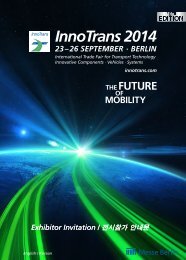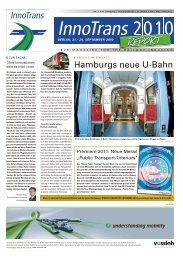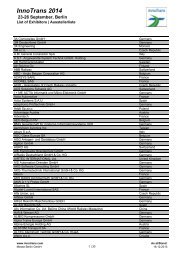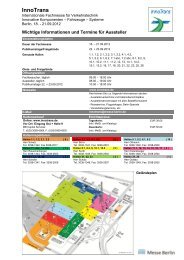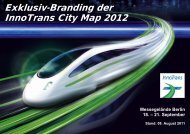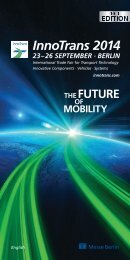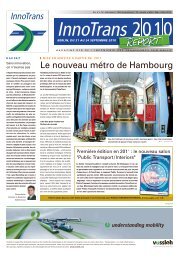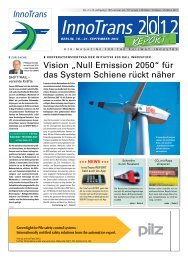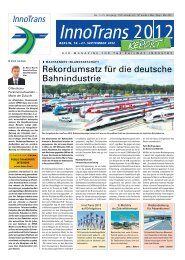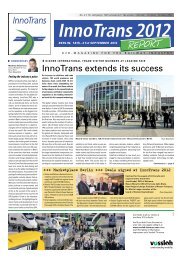here (PDF, 24.8 MB) - InnoTrans
here (PDF, 24.8 MB) - InnoTrans
here (PDF, 24.8 MB) - InnoTrans
Create successful ePaper yourself
Turn your PDF publications into a flip-book with our unique Google optimized e-Paper software.
V<br />
Vigier Rail:<br />
LVT trafficability solution for emergency vehicles<br />
The Swiss company Vigier Rail, together with the licensor, Sonneville,<br />
has introduced a new development for use on the Low Vibration Track<br />
(LVT) slab track system, and this is being presented for the first time<br />
at <strong>InnoTrans</strong> 2012. It enables emergency vehicles running on pneumatic<br />
tyres to operate on LVT rail tracks. This development originated<br />
from the need to meet specific emergency rescue concepts requiring<br />
pneumatically tyred emergency vehicles to be able to access tunnels.<br />
To achieve this the system provider, Sonneville AG, has developed a<br />
new LVT support with high shoulders, which forms the main feature<br />
of the overall LVT Traffic concept. The track for emergency vehicles<br />
is created by means of an additional concrete layer, cast in-situ, in<br />
combination with the newly developed LVT support points. Specially<br />
designed formwork covers separate the LVT supports and the concrete<br />
for the vehicle track. As a result the outstanding performance<br />
of the Low Vibration Track, in terms of the flush track and protection<br />
against vibration, is retained.<br />
Vigier Rail AG, CH-Müntschemier<br />
Hall 26, Booth 218<br />
Bruno Kiefer<br />
+41 (0)32-3129824<br />
bruno.kiefer@vigier-rail.ch<br />
www.vigier-rail.ch<br />
LVT with new support points<br />
LVT support points with high shoulders<br />
VINCI Energies: Recovering energy from braking<br />
With the innovative capabilities and expertise of its subsidiary Cegelec<br />
Infrastructures & Mobility, VINCI Energies is able to support its<br />
customers in optimising the electricity consumption of their transport<br />
systems. New solutions for recovering braking energy are on<br />
show at <strong>InnoTrans</strong> 2012. The simulation of operating energy system,<br />
for example, enables the number, location and output of transformer<br />
substations to be determined. The aim is to provide customers<br />
with the best technical solution and the best possible returns. This<br />
is dependent on the technology of supercaps, which are installed<br />
in the relevant transformer sub-station or along the track, in order<br />
to store energy generated during braking and to release it again to<br />
propel the rail vehicle. This exhibitor points out that the use of suitable<br />
technology can lead to a 30 per cent reduction in energy costs<br />
for the transport company.<br />
Recovering energy from braking<br />
VINCI Energies, F-Lyon<br />
Hall 4.2, Booth 212<br />
Eric Willart<br />
+33 (0)624-770679<br />
eric.willart@cegelec.com<br />
www.vinci-energies.com<br />
Recovering energy from braking<br />
587



